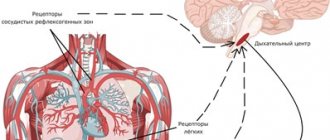Arterial hypertension (AH, hypertension, essential hypertension) - a persistent increase in blood pressure from 140/90 mm Hg. Art. and higher.
The most common is primary hypertension - a persistent increase in blood pressure (BP) not associated with organ dysfunction. The diagnosis of primary hypertension is made based on the exclusion of all secondary hypertension.
Secondary hypertension is an increase in blood pressure, which is based on the pathology of a particular organ or body system. The causes of secondary hypertension are conventionally divided into renal and endocrine.
In renal hypertension, the lumen of the renal arteries narrows, causing insufficient blood to flow to the kidneys. In response to this, the kidneys synthesize substances that increase blood pressure. Diseases that can lead to renal hypertension are chronic glomerulonephritis, chronic pyelonephritis, polycystic kidney disease, congenital narrowing of the renal artery. To exclude or confirm renal hypertension, the patient is prescribed a test - a general urine test, a urine test according to Nechiporenko, a urine test according to Zimnitsky, a blood test for urea, creatinine.
Increased blood pressure associated with hormones is endocrine hypertension. With this pathology, high blood pressure and hormones are inextricably linked. Hypertension is based on one of the diseases of the endocrine organs (thyroid and parathyroid glands, adrenal glands, pituitary gland). This article will discuss in detail the causes of endocrine hypertension.
Hormonal causes of high blood pressure:
- Hyperparathyroidism.
- Hypothyroidism.
- Thyrotoxicosis.
- Acromegaly.
- Pheochromocytoma.
- Primary hyperaldosteronism.
- Hypercortisolism
Classification of secondary arterial hypertension
Arterial hypertension in chronic kidney disease:
- chronic glomerulonephritis;
- chronic pyelonephritis;
- diabetic nephropathy;
- autosomal dominant polycystic kidney disease;
- kidney damage due to systemic vasculitis;
- kidney amyloidosis;
- kidney tuberculosis;
- kidney tumors and injuries;
- nephropathy of pregnant women (primary and secondary);
- congenital anomalies in the number, position, shape of the kidneys: hypoplasia, duplication, kidney dystopia, hydronephrosis, horseshoe kidney. Vasorenal hypertension:
- atherosclerosis of the renal arteries;
- fibromuscular dysplasia of the renal arteries;
- nonspecific aortoarteritis;
- hematomas and tumors compressing the renal arteries;
- congenital pathology: atresia and hypoplasia of the renal arteries, angiomas and arteriovenous fistulas, aneurysms.
Endocrine hypertension:
- damage to the adrenal cortex: hypersecretion of mineralocorticoids (adrenal aldosteroma, hyperplasia of the adrenal cortex against the background of hyperaldosteronism, familial forms of hyperaldosteronism); hypersecretion of glucocorticoids (Cushing's syndrome);
- damage to the adrenal medulla and paraganglions: hypersecretion of catecholamines (pheochromocytoma, paraganglioma);
- dysfunction of the thyroid gland: hypothyroidism; hyperthyroidism;
- hyperparathyroidism;
- damage to the pituitary gland: Cushing's disease; acromegaly.
Arterial hypertension caused by damage to large arterial vessels:
- atherosclerosis;
- coarctation of the aorta;
- stenosing lesions of the aorta and brachiocephalic arteries in nonspecific aortoarteritis.
Centrogenic hypertension:
- with organic lesions of the central nervous system, increased intracranial pressure: tumors, injuries, encephalitis, poliomyelitis, focal ischemic lesions;
- with sleep apnea syndrome;
- lead intoxication;
- acute porphyria.
Arterial hypertension caused by drugs and exogenous substances:
- hormonal contraceptives;
- corticosteroids;
- sympathomimetics;
- mineralocorticoids;
- cocaine;
- foods containing tyramine or monoamine oxidase inhibitors;
- non-steroidal anti-inflammatory drugs;
- cyclosporine;
- erythropoietin.
To diagnose secondary forms of hypertension, it is fundamentally important to conduct a detailed examination of the patient, starting with routine methods: questioning, examination, laboratory diagnostics, and up to complex instrumental studies.
Endocrine hypertension accounts for 3 to 5% of secondary forms of hypertension in patients with endocrinopathies. The most common causes of endocrine hypertension include impaired secretion (usually hypersecretion) of mineralocorticoids (primary hyperaldosteronism), catecholamines (pheochromocytoma), thyroid hormones (Graves' disease, hypothyroidism) and glucocorticoids (Cushing's syndrome).
The doctor must exclude symptoms and signs of Cushing's syndrome, hyper- or hypothyroidism, acromegaly, pheochromocytoma, etc. in a patient with hypertension.
In young patients with hypertension resistant to multicomponent antihypertensive therapy (more than 3 antihypertensive drugs), it is necessary to exclude a secondary cause of the disease. The prevalence of resistant hypertension is very high, ranging from 48 to 53%. Once the diagnosis of secondary hypertension is established, it becomes possible to prescribe pathogenetic therapy, and in some cases, surgical intervention can lead to recovery or no need for lifelong treatment.
Pressure during thyrotoxicosis
Doctors and scientists identify the following provoking factors for arterial hypertension of thyrotoxic origin:
- Toxic diffuse goiter. It appears against the background of genetic pathologies, autoimmune diseases and radioactive influence.
- Pituitary adenoma. When it occurs, an excessive amount of thyroid-stimulating hormone is released, stimulating the function of the thyroid gland, which begins to overproduce T4, T3.
- Malignant neoplasm of the thyroid gland. Primary hyperfunction occurs and the concentration of thyroid hormones in the blood increases.
- Excessive introduction of hormonal drugs into the body for the purpose of replacement therapy after resection of the gland.
- Anomalies of receptor complexes that respond to hormonal molecules.
Due to hormones, cardiac output increases, and this causes increased blood pressure.
The pathophysiological mechanism for the occurrence of one disease against the background of another lies in the properties of hormonal molecules synthesized by the thyroid gland. T3, T4 have a cardiotonic effect on the myocardium, increasing cardiac output. Hormones manage to achieve this by stimulating tachycardia and increasing the volume of blood released into the systemic circulation.
If the primary cause was a violation of the endocrine function of the hypothalamic-pituitary system, the pathophysiological mechanism develops along an alternative path. After an increase in the concentration of antidiuretic and adrenocorticotropic hormones in the cow, the reabsorption of fluid in the renal tubules is activated. BCC increases, hypervolemia appears and blood pressure rises.
Therapy for thyrotoxicosis is carried out according to the scheme. Antithyroid drugs are used to reduce the level of hormones in the blood. The regimen includes medications containing iodine. The patient is advised to take antihypertensive medications to reduce blood pressure. In severe cases, surgery is indicated to remove part or all of the thyroid gland.
- 1 Causes and symptoms 1.1 Clinical picture 1.1.1 Effect of hormones on blood pressure
The thyroid gland is the most important organ of the endocrine system. An excess of hormones produced by it is called thyrotoxicosis. Pressure during thyrotoxicosis increases (pulse and systolic). The disease is dangerous due to complications in the form of thyrotoxic crisis, which can lead to death. Therefore, it is important to undergo examinations at the initial stages and strictly follow the doctor’s prescriptions.
Causes and symptoms
Thyrotoxicosis (also called hyperthyroidism) occurs due to an excess of the hormones thyroxine and triiodothyronine. This pathology is a set of diseases that cause dysfunction of the thyroid gland. There are 3 forms of the syndrome:
- Primary. Associated with hyperfunction of the thyroid gland.
- Secondary. Associated with the production of pituitary hormones.
- Tertiary. Dysfunction of the hypothalamus - a group of cells responsible for the neuroendocrine functioning of the brain and homeostasis of the body.
| Disease | Why does it happen? |
| Toxic goiter of diffuse type (Graves' disease, Graves' disease) | Excess thyroid hormones due to the formation of antibodies that attack its cells. |
| Toxic adenoma (multinodular goiter) | Occurs with thyroid tumors. The nodes produce excess hormones. |
| Pituitary adenoma | Excess of the hormone thyrotropinoma. |
| Thyroiditis | The cells of the thyroid gland are destroyed, which leads to an excess of thyroid hormones. |
| Drug-induced thyrotoxicosis | Develops when taking hormonal drugs. |
| Iodine | Excess or deficiency of a microelement. |
Primary hyperaldosteronism
Among patients with hypertension, the prevalence of primary hyperaldosteronism is about 6%, and hypokalemia (that is, the “classic” variant of primary hyperaldosteronism) is present in only 41% of those examined. Severe hypokalemia is accompanied by polyuria, myopathy and arrhythmias. The prevalence of primary hyperaldosteronism in patients with moderate and severe hypertension without hypokalemia is estimated at 3%, and in patients with resistant hypertension it ranges from 11 to 23%. In patients with adrenal incidentaloma and hypertension, this figure does not exceed 2%. Cardio- and cerebrovascular concomitant diseases are diagnosed in 16% of patients with primary hyperaldosteronism.
Thus, screening for primary hyperaldosteronism is advisable in patients with resistant hypertension, with hypokalemia, with hypertension and a family history of hypertension or acute cerebrovascular accident/acute myocardial ischemia at a young age, as well as in patients with hypertension and incidentaloma adrenal gland
Primary hyperaldosteronism may be sporadic or genetically determined. It was previously thought that the majority of cases of sporadic primary hyperaldosteronism were caused by an aldosterone-producing adrenal adenoma (aldosteroma). However, according to recent studies, bilateral hyperplasia is the most common.
This form of sporadic (idiopathic) primary hyperaldosteronism requires aldosterone antagonist therapy rather than adrenalectomy. For differential diagnosis of these forms, comparative selective blood sampling from the adrenal veins should be carried out. Very rarely, primary hyperaldosteronism may be a consequence of adrenocortical cancer or unilateral adrenal hyperplasia.
Familial hyperaldosteronism occurs in 2% of patients and is traditionally divided into types 1 and 2. Familial hyperaldosteronism type 1 (glucocorticoid (adrenocorticotropic hormone, ACTH)-dependent primary hyperaldosteronism) is a disease with an autosomal dominant inheritance pattern. In it, mutation of the chimeric CYP11B1/CYPB2 gene encoding 11-beta-hydroxylase/aldosterone synthase causes ectopic expression of aldosterone synthase activity in the cortisol-producing zona fasciculata, triggering ACTH-regulated mineralocorticoid hypersecretion. The hybrid gene was identified on chromosome 8.
Normally, aldosterone secretion is stimulated mainly by hyperkalemia and angiotensin. An increase in serological potassium by 0.1 mmol/l increases aldosterone levels by 35%. In familial hyperaldosteronism type 1, urinary hybrid steroids, 18-hydroxycortisol and 18-hydroxycortisol, are almost 20 times higher than in sporadic aldosteronism. The disease is often associated with cerebral aneurysm and hemorrhagic stroke.
Familial hyperaldosteronism type 1 is diagnosed based on the Liddle test (dexamethasone taken 0.5 mg every 6 hours for 48 hours) when dexamethasone suppresses blood aldosterone to almost undetectable levels (below 4 ng/dL) or by genetic testing.
Familial hyperaldosteronism type 2, on the contrary, is a glucocorticoid-independent variant. In this case, the responsible gene is associated with chromosome 7p22 but has not yet been identified.
Recently, type 3 familial hyperaldosteronism was identified, which is characterized by significant hypersecretion of 18-hydroxyfludrocortisone and 18-hydroxyfludrocortisone (10-1000 times higher than in patients with other types of primary hyperaldosteronism), as well as resistance to drug treatment. Such patients undergo bilateral adrenalectomy. In addition, patients with familial hyperaldosteronism type 3 experience a paradoxical increase in aldosterone after taking dexamethasone in the presence of zona glomerular atrophy, diffuse zona fasciculata hyperplasia, and severe hypertension from early childhood (from approximately 7 years of age).
Primary hyperaldosteronism is diagnosed based on the study of aldosterone, plasma renin activity (or direct renin concentration) and the value of the aldosterone-renin ratio (ARR). For an APC greater than 30 (ng/dL: ng/ml/h) with concomitant aldosterone greater than 20 ng/dL, the sensitivity for primary hyperaldosteronism is 90% and the specificity is 91%. To differentiate low-renin hypertension from primary hyperaldosteronism, one focuses on the level of aldosterone (at least 15 ng/dl for primary hyperaldosteronism).
Because hypokalemia reduces aldosterone secretion, it should be corrected before APC testing. In addition, if the patient is taking angiotensin-converting enzyme inhibitors, angiotensin receptor antagonists, calcium channel blockers, diuretics, that is, drugs that increase plasma renin activity and reduce APC (false negative result), then with suppressed renin levels and elevated aldosterone levels, the diagnosis is primary hyperaldosteronism is most likely.
It is generally recommended to discontinue beta-blockers, angiotensin-converting enzyme inhibitors, angiotensin receptor antagonists, renin inhibitors, dihydropyridine calcium channel blockers and central alpha-2 agonists approximately 2 weeks before the study, and spironolactone, eplerenone, amiloride, triamterene and loop diuretics in 4 weeks. However, this is often not possible in clinical practice.
After determining a diagnostically significant level of APC, confirmatory tests are carried out: a test with fludrocortisone, with a salt and water load, with captopril, and rarely a “marching” test.
To clinically determine a bilateral or unilateral pathological process, computed tomography or magnetic resonance imaging alone is not enough. In this case, a comparative selective blood sampling from the adrenal veins is carried out with (or without) ACTH to clarify the lateralization of the process. Comparative selective blood sampling from the adrenal veins and computed tomography or magnetic resonance imaging data of the adrenal glands identify unilateral lesions in 60.5 and 56% of cases, respectively, but only in 37% (!) of cases the affected side was the same.
For aldosteroma, surgical treatment is indicated. In almost all patients, the course of hypertension improves, and in 60% of patients antihypertensive therapy is not required at all. Of course, the result depends on various factors, including age, duration of hypertension, the presence of renal failure, use of more than 2 antihypertensive drugs in the preoperative period, family history, etc.
If the patient refuses adrenalectomy or there are contraindications to it, conservative (drug) therapy is prescribed. For bilateral hyperplasia and before surgical removal of aldosteroma, spironolactone, eplerenone, and amiloride are also used.
The initial dose of spironolactone is 12.5-25 mg per day once. It is necessary to establish the minimum effective dose of spironolactone, gradually increasing it to 100 mg per day or more. To avoid the need for a higher dose of spironolactone (which may have side effects), small doses of a calcium channel blocker, thiazide diuretic, triamterene, or amiloride are added.
Eplerenone is a new selective mineralocorticoid receptor antagonist that does not have antiandrogenic or progestogenic properties. The antagonistic activity of eplerenone is 60% of that of spironolactone. Due to the short duration of action of the drug, it must be taken several times a day, with an initial dose of 25 mg 2 times a day.
Aldosterone synthase inhibitors are currently being studied and do not have the negative effects of previous drugs. Blood pressure can also be adjusted by influencing central (brain) mineralocorticoid receptors.
Treatment of hyperthyroidism
How to treat hyperthyroidism?
Treatment of hyperthyroidism depends on the etiology of the disease, the health and age of the patient, concomitant pathologies and diseases, special conditions (pregnancy, etc.). However, the standard treatment regimen for thyrotoxicosis includes the following points:
1. Drug therapy; 2. Radioiodine therapy; 3. Diet; 4. Surgical treatment.
Treatment of subclinical hyperthyroidism with a concentration of thyroid-stimulating hormones (TSH) <0.1 mIU/l is indicated only if the patient’s age is 65 years or more, or in the presence of concomitant diseases - the cardiovascular system, osteoporosis, as well as special conditions - menopause.
When the TSH concentration is 0.1–0.4 mIU/l – according to the doctor’s indications.
Important! Doctors do not recommend self-medicating thyrotoxicosis, since the drugs used have a number of side effects, contraindications and a narrow focus, which, if used inadequately, can lead to aggravation of the health situation not only of the thyroid gland, but also of other organs - liver, heart, etc.
1. Drug (conservative) therapy for hyperthyroidism
The goal of conservative therapy is to reduce the activity of the thyroid gland's production of thyroid hormones.
1.1. Thyrostatics
Thyreostatic drugs (antithyroid drugs) are drugs that help reduce the activity of the thyroid gland's production of thyroid hormones. Remission occurs after 1-2 years, with hormone levels and the size of the thyroid gland returning to normal. With toxic nodular goiter, remission rarely occurs, therefore, with this form of hyperthyroidism, thyreostatics are used to prepare for surgical treatment or before radioiodine therapy (131I-therapy).
Thiamazole (“Tiamazol”, “Tirozol”, “Mercazolil”, “Methimazol”) is an antithyroid drug that has the properties of blocking thyroid peroxidase, reducing the activity of thyroxine incretion and inhibiting the accumulation of iodine in the body, which in turn is involved in the production of thyroid hormones T3 and T4. In addition, when using drugs based on thiamazole, the removal of iodides from the thyroid gland is accelerated, basic metabolic processes are reduced, the release of thyroid-stimulating hormone by the pituitary gland is accelerated, and at the same time, a slight increase in size of the thyroid gland (hyperplasia) may be observed.
Read also Radiculitis - symptoms, causes, types and treatment of radiculitis
Propylthiouracil (“Propicil”) is an antithyroid agent that has the properties of blocking peroxidase, reducing the activity of converting ionized iodine into its elemental (active) form, and disrupting the iodination of thyroglobulin molecules. Propylthiouracil also inhibits the peripheral conversion of tetraiodothyronine (T4) to triiodothyronine (T3, thyroxine), however, in response to a decrease in the concentration of thyroid hormones in the blood, the pituitary gland increases the secretion of thyroid-stimulating hormone, which causes the thyroid gland to increase in size (goitrogenic effect). Propylthiouracil has a strong toxic effect on the liver, so its use is advisable only in special cases, for example, during thyrotoxic crisis, etc., under the supervision of a physician.
Treatment of severe hyperthyroidism may include high doses of propylthiouracil in combination with dexamethasone (a glucocorticoid), which further inhibits the activity of converting T4 to T3, thereby improving the disease.
1.2. β-blockers
Beta-blockers are a group of drugs that have the property of blocking beta-adrenergic receptors in the body. They are used primarily in the presence of symptoms of hyperthyroidism, such as tachycardia and other arrhythmias, tremor, disturbances in the nervous and mental systems, gastrointestinal disorders, sweating, heat intolerance and other signs of thyrotoxicosis caused by adrenergic stimulation.
The most popular beta-blockers that are used to treat hyperthyroidism are Atenolol, Propranolol, Metoprolol.
In cases of tachycardia and other arrhythmias, and the patient has contraindications to taking β-blockers, the doctor may prescribe calcium channel blockers - Verapamil, Diltiazem and others.
1.3. Iodine
Iodine-containing contrast agent (“Iohexol”, “Sodium Ipodate”, “Iopanoic acid”) - organic iodine, has the property of inhibiting the transformation of hormones T4 into T3, as well as the release of inorganic iodine from it and, accordingly, reducing the synthesis of T4 and T3 from the thyroid gland. It is used primarily in the treatment of thyrotoxic crisis.
“Potassium iodide” is an inorganic iodine that helps reduce the synthesis of thyroid hormones. It is used for thyrotoxic crisis, as well as in preparation for surgery. Contraindicated in case of thyrotoxicosis caused by increased iodine content in the body, as well as during planned treatment with radioactive iodine. It is used in the form of Lugol's solution (8 mg in 1 drop) or a saturated solution of potassium iodide (50 mg in 1 drop). It is used for a short time, in particular, when there are contraindications to taking thyreostatics.
1.4. Other medicines
Glucocorticosteroids (GC - Dexamethasone, Hydrocortisone) are hormones that inhibit the conversion of T4 to T3, which are used in cases where it is necessary to quickly reduce the concentration of thyroid hormones in the shortest possible time. Efficiency increases with simultaneous use of HA with thyreostatics and inorganic iodine.
Sodium perchlorate – has the property of inhibiting the transport of iodine into the thyroid gland. It is used short-term (up to 3-4 weeks), often for iodine-induced thyretoxicosis, because has many side effects, the most severe of which is bone marrow damage.
Lithium carbonate – has the property of inhibiting the proteolysis of thyroglobulin, thereby reducing the release of thyroid hormones.
Antibiotics – used when a bacterial infection is suspected in the body. Until culture results are obtained, an antibiotic is prescribed empirically.
To reduce body temperature, compresses, Paracetamol and other NSAIDs are used. Salicylates are strictly contraindicated.
To relieve nervous system disorders, the doctor may prescribe sedatives or anticonvulsants.
Radioiodine therapy
In some large countries, such as the United States, treatment of hyperthyroidism with radioactive sodium iodide (131I, radioiodine) is becoming increasingly popular. This treatment method is suitable for both Graves' disease (diffuse toxic goiter) and toxic angular goiter. Contraindications to the use of radioiodine are pregnancy, breastfeeding, thyroid cancer due to hyperthyroidism, moderate or severe ophthalmopathy. Some experts talk about an increase in the incidence of thyroid cancer, malignant tumors in other organs, leukemia and other forms of cancer, while others consider such information unproven.
The standard dosage of radioiodine therapy is 8-15 mCi. However, many doctors calculate the dosage depending on the size of the thyroid gland and the amount of 131I absorbed by it in 24 hours.
In many cases, after treating thyrotoxicosis with radioiodine, hypothyroidism (insufficient amounts of T3 and T4 hormones in the body) appears after a few months or years, which is usually treated with replacement therapy, which involves lifelong use of thyroid hormones.
Radioiodine therapy involves the patient taking a capsule or aqueous solution with 131I, which has neither taste nor smell, after which radioiodine, through the bloodstream, enters the hyperactive cells of the thyroid gland and, accumulating, begins to destroy them. Treatment with radioiodine is carried out in combination with conservative therapy. If the required effect is not achieved, the course of treatment with 131I can be repeated.
131I emits β- and γ-radiation, with a wavelength of about 2 mm, and thyroid cells are irreversibly damaged. The remainder of the radioiodine is excreted fairly quickly in the urine.
Read also Arterial hypertension (Hypertension). Causes, symptoms and treatment of hypertension
Diet for hyperthyroidism
The diet for hyperthyroidism is aimed at maintaining the body during illness, eliminating stress on the body and speedy recovery.
Diet features:
- Food should be rich in protein (40% plant and 60% animal origin) and easily digestible fats;
- Loss of calcium (Ca) and phosphorus (P) must be prevented;
- Focus on eating foods fortified with vitamins and minerals.
What can you eat with hyperthyroidism: dairy products, lean meats and freshwater fish (chicken, beef, pike perch, bream, pike), low-fat soups and broths, bread and pastries (without fatty creams), any vegetables and fruits (except those which increase flatulence, cause constipation or diarrhea), eggs, drinks (weakly brewed green or black tea, jelly, compote, dried fruit decoction), it is better to use honey as a sweetener.
Pheochromocytoma
In most cases, pheochromocytoma is a rare neuroendocrine tumor of chromaffin tissue that secretes epinephrine and norepinephrine and is a sporadic tumor. The hereditary cause of chromaffin tumors is detected in more than 30-40% of patients. Multiple endocrine neoplasia types 1 and 2, Hippel-Lindau disease, neurofibromatosis type 1, familial paragangliomas are the most studied familial syndromes. Given the severe illness associated with these syndromes, genetic testing should be performed in patients at risk.
In approximately 15% of patients, pheochromocytoma does not cause clinical symptoms. Arterial hypertension may be paroxysmal in up to half of patients with pheochromocytoma. Most patients with pheochromocytoma have specific symptoms of the disease: headaches, episodes of anxiety, panic and rapid heartbeat, profuse sweating. In a patient with hypertension, the triad of signs of headache, palpitations and profuse sweating has a sensitivity of 91% and a specificity of 94% for pheochromocytoma.
Diagnosis is made by testing free plasma or fractionated urinary levels of metanephrine and normetanephrine. If the results are questionable, it is possible to study plasma chromogranin A or conduct a test with clonidine. The sensitivity of the combination of plasma chromogranin A and urinary catecholamine results for pheochromocytoma reaches almost 100%. In rare cases, pheochromocytoma produces large amounts of dopamine.
Approximately 35% of extra-adrenal and 10% of adrenal pheochromocytomas are malignant. The risk of malignant potential increases significantly with mutations in the SDHB gene. This is why open adrenalectomy is recommended for such tumors rather than a laparoscopic approach.
Computed tomography or magnetic resonance imaging visualizes the tumor in 95% of cases. For malignant pheochromocytoma, 18F-fluorodopamine positron emission tomography is superior to 123I-methaiodobenzylguanidine or 131I-methaiodobenzylguanidine scintigraphy. For patients with paragangliomas of the head and neck, scintigraphy with 111In-octreotide has proven itself.
Almost 50% of patients with malignant pheochromocytoma respond to 131I-metaiodobenzylguanidine therapy with partial remission or at least stabilization. Chemotherapy is usually used according to the so-called Averbukh protocol. Tyrosine kinase inhibitors may be used for some patients.
Symptoms of the disease
Hypertension secondary to endocrine disorders is not necessarily manifested by objective symptoms; it is often diagnosed incidentally. A nonspecific symptom is headache and a number of heterogeneous manifestations.
Endocrine hypertension is suspected in the following cases:
- treatment resistance;
- manifestation of the disease at a young age;
- sudden deterioration of condition;
- sudden onset of severe form;
- typical clinical picture and laboratory signs of secondary hypertensive disease.
Congenital adrenal dysfunction: 11-beta-hydroxylase deficiency
Arterial hypertension can be one of the clinical symptoms of congenital adrenal dysfunction, about 5% of cases of which are a consequence of 11-beta-hydroxylase deficiency. This enzyme is responsible for converting deoxycorticosterone to corticosterone (a precursor to aldosterone) and 11-deoxycortisol to cortisol.
Up to ⅔ of patients have low-renin hypertension with low aldosterone levels due to the accumulation of 11-deoxycortisol and deoxycorticosterone. Since the ACTH level is increased, the level of 17-OH-progesterone and androstenedione correspondingly increases, androgen secretion increases, which leads to prenatal virilization and pseudohermaphroditism in girls. Boys are characterized by an early onset of puberty.
The disease is transmitted according to an autosomal recessive mode of inheritance. The responsible gene, CYP11B1, is located on chromosome 8. In these patients, glucocorticoid therapy usually corrects hypertension.
Congenital adrenal dysfunction: 17-alpha-hydroxylase deficiency
This rare syndrome is characterized by deficiencies of cortisol, aldosterone, and adrenal androgens. Elevated ACTH levels stimulate hypersecretion of deoxycorticosterone, 18-hydroxycorticosterone and corticosterone with the development of hypertension, hypokalemia, hypoaldosteronism and hyporeninemia, pseudohermaphroditism in boys and primary amenorrhea in girls. The level of 17-hydroxyprogesterone is reduced. Blood pressure is corrected with glucocorticoid therapy. The responsible gene, cytochrome P450C17, is located on chromosome 10q24.
False mineralocorticoid excess syndrome
Low-renin hypertension against the background of hypoaldosteronism and hypokalemia can have various variants of the course of the disease. One of them, apparent mineralocorticoid excess syndrome, has an autosomal recessive pattern of inheritance and is caused by 11-beta-hydroxysteroid dehydrogenase type 2 deficiency (11PHSD2).
In 1977, MI New et al. first described this syndrome, and in 1995 RC Wilson et al. identified a mutation in the 11β-HSD2 gene, located on chromosome 16q22. The enzyme 11β-HSD2 is expressed by mineralocorticoid receptors in the kidney and converts cortisol to cortisone. It does not have mineralocorticoid activity, that is, it does not bind to mineralocorticoid receptors, but cortisol and aldosterone, on the contrary, bind with equal affinity. But normally, circulating concentrations of cortisol are 100-1000 times higher than aldosterone. Under conditions where the 11β-HSD2 enzyme is defective, there is even more cortisol.
The disease can be either genetically determined or sporadic. In sporadic cases, 11β-HSD2 deficiency is caused by the inhibitory effect of glycyrrhizic acid, which can be found in licorice and chewing tobacco.
In children, mineralocorticoid excess syndrome is often associated with growth retardation, hypertension, hypokalemia, nephrogenic diabetes insipidus, and nephrocalcinosis. Decreased enzyme activity may play a role in the pathogenesis of preeclampsia. The diagnosis is established by examining the ratio of free unconjugated steroids in urine (free cortisol / free cortisone more than 0.5) and / or steroid metabolites (tetrahydrocortisol + allotetrahydrocortisol / tetrahydrocortisone). Patients are prescribed spironolactone, eplerenone, triamterene, or amiloride.
Liddle syndrome
In 1963, GW Liddle first described patients with severe hypertension, hypokalemia and metabolic alkalosis in the presence of hypoaldosteronemia and hyporeninemia. Patients are prescribed a strict salt-free diet and triamterene; spironolactone is ineffective. This is a disease with an autosomal dominant pattern of inheritance. The gene, located on chromosome 16p13, encodes the beta or gamma subunit of renal epithelial sodium channels. The gene mutation leads to hyperactivation of sodium absorption in the kidneys and subsequent hypervolemia. The cortisone/cortisol ratio in daily urine is within normal limits.
Pseudohypoaldosteronism type 2
Gordon's syndrome, or pseudohypoaldosteronism type 2, is a rare disease with an autosomal dominant mode of inheritance (chromosomes 1, 12 and 17), caused by disruption of the amiloride-sensitive sodium channels in the distal renal tubules and manifested by low-renin hypertension, hyperkalemia, metabolic acidosis, low or normal aldosterone levels.
Arterial hypertension results from increased renal sodium reabsorption, and hyperkalemia results from decreased renal potassium excretion, as in hypoaldosteronism. Treatment consists of administering sodium chloride instead of sodium bicarbonate and administering thiazides, which inhibit sodium reabsorption in the distal nephron. Strict salt restriction is recommended. Mutations were identified in the WNK family kinase genes WNK1 and WNK4 on chromosomes 12 and 17, respectively.
Insulin resistance
Metabolic syndrome is characterized by hypertension, visceral obesity, dyslipidemia and insulin resistance. At least 24% of adults meet the criteria for metabolic syndrome, and for patients over 50 years of age this proportion is even higher.
Insulin resistance is associated with hypertension and causes vascular dysfunction. Excess weight increases the risk of hypertension by 70% and increases the risk of end-stage renal failure. Insulin, in tissues sensitive to it, can directly stimulate calcium channels, which leads to the removal of calcium from the cell.
In the adipocyte, elevated cytosolic calcium concentrations induce insulin resistance. In a cell that is resistant to insulin, the release of calcium from the cell is reduced. Such vascular smooth muscle cells respond more actively to vasoconstrictors and thus lead to an increase in blood pressure. Along with this, with insulin resistance, sodium retention in the body and hyperactivation of the adrenergic nervous system are noted.
In obesity, high levels of adipokines (bioactive peptides secreted by adipose tissue) additionally stimulate insulin resistance, disrupt lipid metabolism and worsen the course of hypertension.
General principles of diagnosis and treatment
If this disease is suspected, markers of endocrine arterial hypertension must be studied. Diagnosis of a pathological process consists of a number of research activities:
- Clinical blood test;
- Blood chemistry;
- MRI of the pituitary gland and adrenal glands;
- CT scan of the pituitary gland and adrenal glands;
- Blood test for carbohydrate metabolism;
- Urine analysis for the content of hormones and their breakdown products.
At the discretion of the doctor, other diagnostic procedures may be performed to help assess the current condition of internal organs that could be affected by endocrine arterial hypertension.
Drug treatment
Endocrine hypertension, which has a detrimental effect on the condition of the arteries and internal organs, requires drug treatment. Hypertension of this type is suppressed using different groups of drugs. When selecting them, some nuances are taken into account:
- Age of the patient;
- General health;
- Diseases that have affected the increase in blood pressure;
- Complications;
- Treatment prognosis.
Hyperparathyroidism
Patients with severe hypertension usually have increased calcium excretion compared to patients without hypertension, resulting in hypersecretion of parathyroid hormone. A short-term increase in parathyroid hormone and calcium has a vasodilatory effect, but chronic hyperparathyroidism and hypercalcemia are accompanied by hypertension with the development of endothelial dysfunction.
In patients with primary hyperparathyroidism, hypertension is observed in 40% of cases. To correct blood pressure, multicomponent antihypertensive therapy may be required. After parathyroidectomy, it is possible to reduce the amount and dose of antihypertensive drugs or their complete abolition. In multiple endocrine neoplasia syndromes, hypertension in patients with hyperparathyroidism may be associated with the presence of pheochromocytoma.
Causes of hyperthyroidism
The most common causes of hyperthyroidism are:
Diffuse toxic goiter (Graves' disease, Graves' disease, Perry's disease) is a disease of the thyroid gland of an autoimmune nature, characterized by increased production of thyroid hormones by the diffuse thyroid tissue and an increase in the size of this organ. The mechanism of development of the disease is the production of antibodies against the receptors of thyroid-stimulating hormones of the pituitary gland.
Nodular toxic goiter (Plummer's disease, toxic adenoma of the thyroid gland) is a benign thyroid tumor in which thyroid hormones are produced autonomously, i.e. without pituitary control.
Subacute thyroiditis (de Quervain's thyroiditis) is an acute viral inflammatory disease of the thyroid gland, characterized by the destruction of thyrocytes (follicular cells of the thyroid gland), which causes excess amounts of triiodothyronine (T3) and thyroxine (T4) to enter the blood. The disease is temporary (from 1 to several months) and has a relatively mild course.
Autoimmune thyroiditis (AIT, Hashimoto's thyroiditis) is an autoimmune chronic inflammatory disease of the thyroid gland, accompanied by gradual damage and destruction of the follicles and follicular cells (thyrocytes) of the thyroid gland. The course is usually asymptomatic; only an increase in size of the gland is noted.
A pituitary tumor is a benign or malignant tumor of the pituitary gland, which in turn leads to disturbances in the functioning of the thyroid gland. This is due to the fact that the pituitary gland is also a gland that plays the role of regulating all other glands of the endocrine system.
Other causes of hyperthyroidism
- Uncontrolled use of medications based on thyroid hormones;
- Autoimmune diseases of the body;
- Injury to the thyroid gland or pituitary gland;
- Struma of the ovary;
- Overdose of the body with iodine.
- Unfavorable factors for the development of thyrotoxic crisis
- Presence of infectious diseases;
- Stress;
- Great physical stress on the body.
Hypercortisolism
Patients with Cushing's syndrome often complain of changes in appearance, weight gain, increased glycemia, insomnia, depression, weakness, acne, ecchymosis and hirsutism (in women).
Arterial hypertension is associated with hypercortisolism in approximately 80% of cases in adults and in 50% of cases in children. In 30% of patients, hypertension does not regress after surgical treatment. In most children, normalization of blood pressure occurs within a year, depending on the degree and duration of preoperative hypercortisolemia. In Cushing's syndrome, renin and deoxycorticosterone levels are usually normal, whereas in ACTH-ectopic syndrome, hypokalemia occurs, leading to decreased renin levels and increased deoxycorticosterone.
There are several mechanisms for increased blood pressure in Cushing's syndrome: increased hepatic angiotensinogen production and cardiac glucocorticoid load, decreased prostaglandin production due to phospholipase A inhibition, increased insulin resistance, hyperactivation of 11β-HSD, and stimulation of mineralocorticoid receptors.
Diagnosis of Cushing's syndrome includes a study of 24-hour urinary free cortisol excretion, an overnight test with 1 mg of dexamethasone, a study of nighttime saliva for cortisol, determination of the circadian rhythm of cortisol secretion, and other tests.
Treatment is surgical removal of corticosteroma or corticotropinoma or ACTH-secreting tumor. Hypokalemia is usually corrected with mineralocorticoid receptor antagonists.
Endocrine symptomatic hypertension
Arterial hypertension is a persistently elevated blood pressure level of 140/90 mm Hg. Art. According to statistics, 80-90% of patients have primary (essential) hypertension, the remaining 5-10% have secondary (symptomatic) hypertension.
Symptomatic arterial hypertension is based on diseases of various internal organs, which can even indirectly affect blood pressure levels.
In such a situation, hypertension is not a separate disease, but only pronounced symptoms of another pathology.
Symptomatic hypertension is divided into 4 main types: renal, hemodynamic, central and endocrine.
With the development of endocrine diseases, the amount of hormones produced changes, which affects the change in readings on the tonometer.
Often, with diseases of the endocrine system, the patient experiences not only an increase in blood pressure, but also hypertensive crises, which are very dangerous.
Symptomatic arterial hypertension is distinguished by a persistent course of the disease and resistance to hypotonic drugs. It also negatively affects target organs: heart, kidneys.
Symptomatic hypertension has a number of differences:
- Involves the age category of people under 20 and over 60 years old.
- Characterized by a sharp rise in blood pressure and its persistent consolidation at high levels.
- Intensive progression of the disease with malignant manifestations.
- The onset of periodic panic attacks.
- Lack of positive response to antihypertensive drugs.
- Increased lower values in the presence of renal hypertension.
- Detection of causative pathologies in the history taking.
Distinctive symptoms contribute to the establishment of a rational diagnosis and correct treatment.
Endocrine hypertension can develop against the background of the following pathologies:
- malfunction of the adrenal glands (pheochromocytoma, Conn's syndrome);
- excess amount of thyroid hormones (hypothyroidism, thyrotoxicosis);
- disorders of the pituitary gland (acromegaly, Cushing's disease).
With the development of these pathologies, hypertension is a symptom of the underlying disease and has high rates (from 160/100 mm Hg).
Causes of pathology
The endocrine glands produce hormones that are responsible for maintaining the normal internal state of the body. Hormones are highly active substances.
Even their minimal excess has a powerful negative effect on internal organs and systems. Among all the direct and indirect functions of hormones, they are responsible for regulating blood pressure levels.
This task lies with the adrenal hormones, thyroid hormones of the thyroid gland and pituitary hormones.
Pituitary
The pituitary gland is located in the central part of the brain and is small in size (about the size of a little fingernail).
The pituitary gland's functions include controlling the functioning of the endocrine glands and producing chemicals that control the production of secondary hormones.
Insufficient or excessive production of pituitary hormones can lead to the development of severe diseases or negative symptomatic consequences.
- With an excess amount of somatotropic hormone, gigantism develops at a young age, and acromegaly in adulthood. The result of its increase is arterial hypertension, while the pressure is not lowered by conventional antihypertensive drugs, which allows the disease to become persistent.
- An increase in the level of adrenocorticotropic hormone stimulates the occurrence of Cushing's disease, which is manifested by increased bone fragility, diabetes mellitus, psychoemotional disorders and a persistent increase in blood pressure.
Diagnosis and prescription of therapeutic therapy for pituitary gland pathologies are carried out in the department of endocrinology. Self-medication can lead to complications of the disease and a deterioration in the general condition of the patient.
Adrenal glands
Hormones of the adrenal glands, namely the inner (brain) layer (adrenaline and norepinephrine) and the outer (cortical) layer (glucocorticoid and mineralocorticosteroid hormones) create a protective-adaptive reaction of the heart and blood vessels to the influence of external negative factors.
Adrenaline increases myocardial function, minute volume and pulse rate, which leads to an increase in blood pressure. Norepinephrine is formed at nerve endings and has a direct effect on vascular tone.
In this case, norepinephrine has a stronger pressor effect than adrenaline. Excessive release of norepinephrine causes rapid volume limitation of blood vessels, sometimes to the point of complete interruption of blood flow.
As a result, like adrenaline, norepinephrine increases blood pressure levels, and hypertension develops.
Excessive secretion of cortical hormones is provoked by excess production of a highly active adrenocorticotropic substance. Corticosteroids increase the sensitivity of vascular walls to the influence of catecholamines on them, which provokes a number of vascular reactions, among which an increase in pressure plays a major role.
Mineralocorticoids, namely aldosterone, have a negative effect on vascular tone. The effect of aldosterone on blood pressure is due to increased sodium absorption in the renal tubules and an increase in its amount in the blood. Sodium stagnates in the walls of blood vessels, causing an increase in their tone and the formation of a hypertensive state.
Thyroid
The thyroid gland synthesizes thyroid hormones, excess or insufficient quantities of which affect the health of the body. Chemically active substances have an effect on blood pressure: thyroxine and triiodothyronine. Normally, they increase in stressful situations, during physical activity and at low ambient temperatures.
If the thyroid gland regularly produces excess amounts of these hormones, a disease called hyperthyroidism develops. The disease provokes increased heart contractions and narrowing of the lumen of the arteries, which as a result is reflected in the level of blood pressure.
Background diseases
The main causes of the development of endocrine symptomatic hypertension are: acromegaly, thyrotoxicosis, hypercortisolism, Conn's syndrome, pheochromocytoma and others.
Acromegaly
Acromegaly is a complex chronic pathology that provokes the development of tumors in the pituitary gland, which negatively affects the production of growth hormone.
Any changes in this substance lead to disruptions in mineral metabolism in the body, causing its increased concentration in the blood. The result of disruption is fluid retention and an increase in circulating blood volume.
All this affects the increase in blood pressure and the development of hypertension.
Changes in the patient's appearance that are typical for its development help identify the disease. People suffering from acromegaly gradually experience the following changes:
- the skin of soft tissues and superciliary arches thickens;
- fingers thicken;
- the size of the feet, lips, nose, and tongue increases.
Such changes occur over a long period of time. Comparing old and new photographs helps determine the disease.
If hypertension is detected in combination with the above clinical observations, then the diagnosis of acromegaly is fully confirmed.
Thyrotoxicosis
Thyrotoxicosis is an excess of thyroid hormones in the blood. This chemical affects the functioning of the cardiovascular system. Under the influence of hormones, the following symptoms are expressed:
- cardiopalmus;
- increased cardiac output;
- narrowing of the lumen of blood vessels.
These manifestations provoke the occurrence of persistent arterial hypertension.
Due to this cause of hypertension, the patient experiences increased nervousness and irritability, drowsiness, sweating, insomnia, and trembling in the fingers.
Cushing's disease
Cushing's disease causes primary damage to the pituitary gland, and the syndrome causes a tumor of the adrenal cortex. As a result of the disease, excessive secretion of cortisol is produced, which activates the sympathetic division of the autonomic nervous system and provokes the development of arterial hypertension.
If endocrine hypertension develops against the background of Cushing's disease, the patient will experience typical symptoms:
- loss of objective perception of the environment;
- clouding of the eye lenses;
- obesity in the waist, neck, face, with typical stretch marks on the skin;
- excessive hair growth in women according to the androgenic type in men;
- muscle weakness;
- accumulation of blood between layers of tissue;
- decreased bone density;
- disruptions in the menstrual cycle in women;
- diabetes.
Also, the symptoms of the disease bring negative changes in the patient’s appearance. The face becomes moon-shaped, with a crimson blush and pronounced Mongoloid appearance.
Conn's syndrome
Primary hyperaldosteronism, or Conn's syndrome, appears due to an increased amount of aldosterone (salt-retaining hormone) in the adrenal cortex. Excessive production of it leads to an imbalance of electrolytes, with a large loss of potassium.
Conn's syndrome is the most common cause of endocrine arterial hypertension. With the development of hypertensive pathology against the background of primary hyperaldosteronism, the following are added to the main clinical manifestations:
- muscle weakness;
- paroxysmal paralysis of the legs;
- spasms of the limbs;
- frequent urge to urinate with copious amounts of urine;
- undying feeling of thirst.
Hypertensive crises with the development of acute left ventricular failure, stroke, and arbitrary myocardial arrest are also possible. Pressure in this pathology ranges from 150/90 – 180/100 mm Hg. Art. Increased levels appear with nodular adrenal hyperplasia.
To treat malignant hypertension, surgical intervention is performed, which helps normalize blood pressure in 50-70% of patients. Before the operation, the patient adheres to a hyposodium diet, and also takes drugs that block aldosterone receptors.
Pheochromocytoma
Pheochromocytoma is a tumor, the formation of which takes place in the cells of the inner layer of the adrenal glands, where the hormones adrenaline and norepinephrine (popularly called the hormones of fear and aggression) are produced.
They have a pressor effect on the vessels, as a result of which their lumen narrows and the pressure level rises.
The result of the release of an increased amount of catecholamines into the bloodstream, which is typical for pheochromocytoma, is a sharply increased blood pressure and persistent hypertension.
Hypertensive attacks are severe: attacks of tachycardia are observed, attacks are accompanied by increased pulsation of the arteries and extrasystole.
During the development of pheochromocytoma, patients experience periodic hypertensive crises. The pathology can be cured exclusively by surgery.
Before surgery, blood pressure is regulated using adrenergic blockers.
Endocrine arterial hypertension has a distinct symptomatic picture, characteristic of the action of a particular hormone. This helps to determine the direct pathogenesis of the disease and prescribe rational treatment.
Source: https://cardiograf.com/gipertenziya/vidy/jendokrinnye-simptomaticheskie-gipertenzii.html
Resistance to glucocorticoids
Due to an inactivating mutation of the glucocorticoid receptor gene, a rare autosomal recessive or dominant pathology of glucocorticoid resistance occurs. Against the background of an increase in cortisol and ACTH levels, the clinical symptoms of Cushing's syndrome do not appear. Persistently elevated ACTH levels lead to hypersecretion of adrenal metabolites with mineralocorticoid activity (corticosterone, deoxycorticosterone) and, additionally, elevated cortisol levels stimulate mineralocorticoid receptors, which manifests as hypertension.
Stimulation of androgen secretion (androstenedione, dehydroepiandrosterone, dehydroepiandrosterone sulfate) in women leads to hirsutism, acne, oligomenorrhea and infertility. In children, false hermaphroditism and early puberty are observed. Men are diagnosed with infertility and/or oligospermia. Arterial hypertension in this disease is controlled by taking mineralocorticoid receptor antagonists or suppressing ACTH secretion with dexamethasone (13 mg per day).
Complications of hyperthyroidism
- Anorexia;
- Jaundice;
- Thyroid diabetes;
- Thyrotoxic muscle paralysis (reversible);
- Decreased lung capacity;
- Osteoporosis;
- Infertility;
- Depression;
- Amenorrhea;
- Thyrotoxic crisis (cases recorded only in women) is a special condition when all the symptoms of thyrotoxicosis intensify many times, fever appears, which can put the patient into a coma, and then to death. Another option for the course of the crisis is complete apathy towards everything, cachexia (severe exhaustion of the body).
Read also Chlamydia - symptoms, causes, treatment and consequences of chlamydia
Thyrotoxicosis
Hyperthyroidism increases systolic blood pressure due to increased heart rate, decreased vascular resistance, and increased cardiac function. Almost a third of patients with hyperthyroidism have hypertension, which often regresses once euthyroidism is achieved.
For the period until euthyroidism is achieved, and often for a longer period, it is advisable to prescribe beta-blockers to patients with manifest thyrotoxicosis. Subclinical hyperthyroidism may contribute to left ventricular hypertrophy and thus the development of hypertension.
Endocrine hypertension
Blood pressure depends on many factors, including the functioning of the adrenal glands. Endocrine hypertension is an increase in blood pressure due to impaired hormone production. This is a secondary form of the disease and is rare, occurring in up to 1% of cases. The symptoms of the pathology do not differ from other types of hypertension, which complicates the diagnostic process. Therapy requires an integrated approach, in which the emphasis is on eliminating the underlying disease.
Hypothyroidism
Hypothyroidism worsens endothelial function and increases systemic vascular resistance, extracellular fluid volume, and diastolic blood pressure. In 32% of patients, levothyroxine replacement therapy results in a decrease in diastolic blood pressure of less than 90 mmHg. Art. There are positive correlations between thyroid-stimulating hormone levels and diastolic blood pressure. There is no consensus among experts regarding the connection between subclinical hypothyroidism and hypertension.
Acromegaly
The prevalence of hypertension in patients with somatotropin hypersecretion is approximately 46%. Somatotropin has antinatriuretic properties; its increased secretion leads to sodium retention and hypervolemia. Increased systolic output and high heart rate as a manifestation of hyperkinetic syndrome can cause congestive heart failure.
The renin-angiotensin-aldosterone system is also involved in hypertension. Blood pressure increases further in patients with impaired glucose tolerance or diabetes mellitus. The course of concomitant pathologies with acromegaly (hypertension, dyslipidemia, diabetes mellitus and cardiomyopathy) can improve even with partial control of somatotropin hypersecretion.
Key reasons
Arterial hypertension, depending on the etiology, is primary and secondary. In the first case, we are talking about the development of the disease as a result of unknown factors. Secondary or symptomatic forms of the disease imply the formation of a syndrome against the background of an existing pathological process in organs or systems. Blood pressure increases as a result of disruption of the process of hormone secretion by the adrenal glands and thyroid gland.
Primary hyperaldosteronism
This form of the disease is observed in 0.5% of all patients and involves the production of excess aldosterone. With hyperaldosteronism of the primary type, myalgia, paresthesia, polyuria, and hypokalemia occur. There is a high likelihood of problems with vision and concentration. Depending on the etiology, several forms of diseases are considered:
- Conn's syndrome;
- adrenocortical carcinoma;
- primary type adrenal hyperplasia;
- bilateral glandular hyperplasia.
Return to contents
Pheochromocytoma
Hormonal tumor developing from the adrenal medulla. Pathology is observed in no more than 0.2% of cases, but is highly dangerous for the patient’s life. The symptoms are varied and difficult to distinguish from the general signs of hypertension. Specific manifestations include hyperglycemia.
Hypertension in pheochromocytoma manifests itself in different ways: in 50% of cases the symptoms are permanent, and a chronic form of the disease is diagnosed. Half of the cases manifest as attacks that last up to 30 minutes. During the intercrisis period, blood pressure is at a normal level; slightly elevated systolic values may be observed. Specialized instrumental and laboratory diagnostics are required; based on the results, surgical treatment is prescribed.
Hypothyroidism and hyperthyroidism
The amount of hormones produced by the thyroid gland affects blood pressure levels and this factor can provoke arterial hypertension. Hyperthyroidism or thyrotoxicosis is accompanied by excessive production of hormones that accelerate metabolic processes. As a result, systolic pressure increases, but diastolic pressure remains normal. With thyrotoxicosis, the heart rate and the amount of blood that is ejected during systole significantly increase.
Hypothyroidism is a pathology in which the thyroid gland produces insufficient amounts of hormones, resulting in an increase in diastolic pressure. The heart rate decreases. Both conditions require urgent comprehensive treatment. Diagnosis requires a mandatory examination of the thyroid gland.
Other potential endocrine causes of hypertension
A number of studies have shown that vitamin D deficiency can be a trigger for increased cardiovascular risk and hypertension, which is associated with insulin resistance and disruption of the renin-angiotensin-aldosterone system.
Testosterone deficiency is often detected in patients with obesity, diabetes mellitus and/or metabolic syndrome, including hypertension. Replacement therapy for some patients can be effective not only against decreased libido, erectile dysfunction, fatigue, but also against metabolic syndrome and hypertension.
There is evidence that somatotropin deficiency is also associated with hypertension, mainly due to excess body weight. Thus, in obese patients, along with lifestyle and nutritional changes to reduce body weight, temporary connection to somatotropin therapy may be considered.
Individual characteristics of the tissue-specific sensitivity of glucocorticoid receptors and the action of endogenous glucocorticoids may play a significant role in the development of hypertension, obesity, and diabetes mellitus and require further study.











